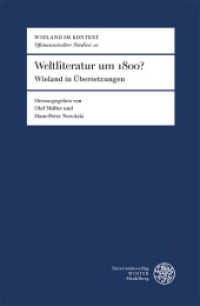- ホーム
- > 洋書
- > ドイツ書
- > Mathematics, Sciences & Technology
- > Biology
- > basics
Full Description
Fungi are associated with a wide variety of other organisms. Ecologist Peter Price has said, "mutualism facilitates adaptive radiation," and many biologists attribute Earth's great fungal diversity to such associations. The 3rd edition of The Mycota, Vol. 9: Fungal Associations, has been revised to provide entirely new coverage of fungi and associated organisms in fourteen informative discussions that take advantage of today's large public databases and modern molecular and data analysis methods. The editors have a keen interest in fungal associations in their own research, and their perspectives from different generations have resulted in an interesting treatment of the subject.
Fungal Associations includes updates of classic topics, but also introduces less frequently discussed associations and broader reflections on the nature of fungi and their associates.
The volume begins with a look at more than abillion years of fungal evolution and associations through the lens of immunology.
Can fungi involved in obligate symbioses be cultivated apart from the host? Genomes help to answer the question.
The ultimate intimacy between fungi and certain unrelated organisms has resulted in DNA exchange that can be traced in extant genomes.
Fungi and bacteria use volatile compounds to lure participants into interactions.
Some viruses modify the phenotype of their fungal hosts and affect host fitness.
Details of interactions between classical examples of fungus—plant symbioses (lichens, several types of mycorrhizae, and toxic endophytes) benefit from advanced microscopic and molecular techniques.
Discussions of fungi associated with insects (entomopathogens, a Drosophila model to study entomopathogens), nematode-trappingfungi and their prey, and a group of termite-associated fungi that produce secondary metabolites with potential uses as pharmaceuticals, complete the volume.
Fungal Associations is a well-illustrated, thought-provoking resource for specialists and generalists, including researchers, lecturers, and students interested in ecology, evolution, microbiology, and mycology. The volume would be an excellent text for a seminar course for advanced undergraduate or graduate students.
Contents
Chapter 1. When Plants and Animals First Met Fungi: Insights from the Evolution of Host Immune Systems.- Chapter 2. Metabolic Constraints and Dependencies Between "Uncultivable" Fungi and Their Hosts.- Chapter 3. Horizontal Gene Transfer in Fungi and Its Ecological Importance.- Chapter 4. An Overview of Fungal Volatile Organic Compounds (VOCs).- Chapter 5. Viruses that Affect Phenotype and Fitness of Fungi.- Chapter 6. Lichens.- Chapter 7. Umbilicaria muhlenbergii: A Model for Studying Molecular Mechanisms Regulating Initial Fungal Symbiotic Interactions with Algal Cells.- Chapter 8. After Air, Light and Water, the Next Most Important Thing Is Grass: An Introduction to the Epichloë-Grass Symbiosis.- Chapter 9. Signals and Host Cell Remodeling in Arbuscular Mycorrhizal Symbiosis.- Chapter 10. Masters of Manipulation: How Our Molecular Understanding of Model Symbiotic Fungi and Their Hosts Is Changing the Face of 'Mutualism'.- Chapter 11. Nematode-Trapping Fungi and Caenorhabditis Elegans as a Model System for Predator—Prey Interactions.- Chapter 12. When a Mind Is Not Its Own: Mechanisms of Host Behavior Control by Parasitic Fungi.- Chapter 13. Genetics and Infection Biology of the Entomopathogenic Fungi.- Chapter 14. Xylaria Sclerotia Formed Within Termite Nests: A Review of Their Biology and Human Uses.








